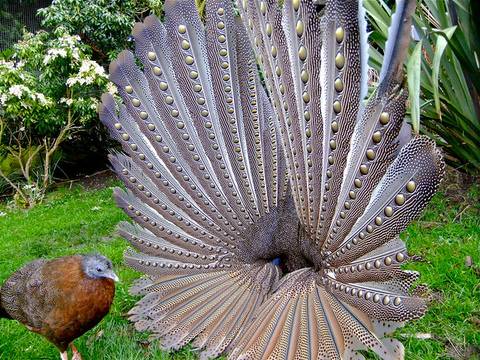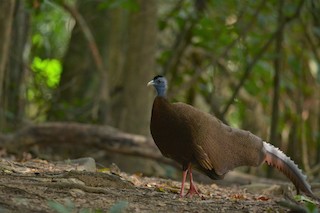Extinction Of Great Argus In Sarawak
Argusianus argus is large-sized bird with measurements around 75200 cm long in which 140 cm is the tail length for an adult male Strange Jeyarajasingam 1993.
Extinction of great argus in sarawak. The Great Argus Pheasant is still widespread but thinly spread. The centre which spans over 50 hectares was opened in 1971 and its primary conservation effort to prevent extinction of endangered wildlife is focus on captive breeding programmes for the gaur sambar deer and several indigenous pheasant species. Nijman Habitat preference in Bornean Argus Pheasants 319 ants and differences in abundance between aimed at collecting data on the effects of dis- habitat types in the Kayan Mentarang National turbance either due to logging hunting or Park generally correspond with the results of shifting cultivation.
The Iban Sarawaks largest ethnic group and once renowned headhunters still live in. Forest destruction in the Sundaic lowlands of Indonesia and Malaysia has been extensive because of a variety of factors including the escalation of logging and land conversion with deliberate targeting of all remaining stands of valuable timber and forest fires. The rapid rate of lowland forest clearance fragmentation of once continuous habitat and increasing bunting pressure owing to increasing accessibility may become serious threats in.
The rapid rate of lowland forest clearance fragmentation of once continuous habitat. The Great Argus Pheasant is still widespread but thinly spread. Created as part of a hydroelectric scheme the 24-square-kilometre Batang Ai Lake boasts Iban longhouses and habitats of wild orangutans in the vicinity.
Genre nature Comment by Flora Laii. It is at the tip of the Muara Tebas peninsula. The majority of the birds are insectivorous 558 foraging either at ground level babblers along the tree trunks or branches woodpeckers or at the canopy flycatchers.
Great Argus is undergoing a decline caused by hunting and habitat loss. The largest and most massive species appears to be the southern ground hornbill which has an average weight of 377 kg 83 lb and can weigh up to 63 kg 14 lb and span about 180 cm 5 ft 11 in across the wings. Great Argus Argusianus argus Linnaeus 1766.
NT and Great. The rapid rate of lowland forest clearance fragmentation of once continuous habitat and increasing hunting pressure owing to increasing accessibility may become serious threats in the near future. Species such as the Sumatran rhinoceros Dicerorhinus sumatrensis has been long considered extinct in Sarawak.
Catastrophic changes in climate or the impact of an asteroid or a comet are the likeliest causes for the five great extinctions which geologists and palaeobiologists have identified ranging from the Ordovician-Silurian extinction of about 439 million years ago to the Cretaceous-Tertiary KT extinction of 65 million years ago when the dinosaurs disappeared. 2019-12-22T023620Z Comment by el3andi. Its commonly known as Great argus pheasant or Kuang Raya in Malay.
The creation of Sarawaks largest man-made lake has provided access to this fascinating national park. Forest Department Sarawak Headquarters Level 15 East Wing Bangunan Baitul Makmur II Medan Raya Petra Jaya 93050 Kuching Sarawak Tel. Gazetted in 1957 the Bako National Park is Sarawaks oldest national park covering an area of 2727 ha.
Assuming that all active arenas were The observed densities of Great Argus Pheas- V. Some of the mammalian species are unique to Borneo and at the same time are Endangered and seeks conservation attention. Seven species are Totally Protected including six species of hornbills and a Great Argus Pheasant while 18 other species are Protected under the Sarawak Wild Life Ordinance 1998.
Numerous extinction events will predictably materialize in the foreseeable future. The Great Argus Pheasant is still widespread but thinly spread. It is one of the smallest national parks in Sarawak yet one of the most interesting as it contains almost every type of.
A natural symphony of frogs insects frogmouths a type of nocturnal bird and a distant Great Argus Pheasant recorded around midnight in Lambir Hills National Park Sarawak Malaysia. More than 95 of forests in southern Thailand have been lost Round Reference Round 1988 due to human activities over the past several decades and such transformations have most likely contributed to the increase in threatened status of vertebrate species found on the northern edge of the Sundaland hotspot such as the Siamang Symphalangus syndactylus Endangered. Argusianus argus is confined to the Sundaic lowlands where it is recorded from south Tenasserim Myanmar peninsular and south-west Thailand Sabah Sarawak and Peninsular Malaysia Brunei extirpated from many areas Kalimantan and Sumatra Indonesia BirdLife International 2001.
Hornbills show considerable variation in size. With a bit of good fortune we will also encounter one or more of the scarcer or shyer species of the area such as Crested Partridge Great Argus usually only heard here White-crowned Hornbill the rare endemic Hoses Broadbill White-necked Babbler or even the monotypic Rail-Babbler. This species is endemic to Sunda land including Peninsular Malaysia and commonly inhabits secondary lowland forest up.
EN Agile gibbon Hylobates agilis EN Rhinoceros hornbill Buceros rhinoceros Near Threatened. The smallest species is the black dwarf hornbill Tockus hartlaubi at 991 g 350 oz and 32 cm 1 ft 1 in in length.









